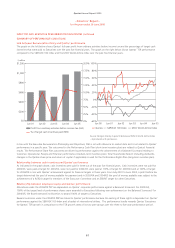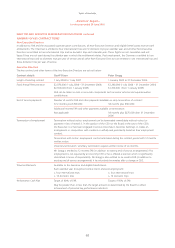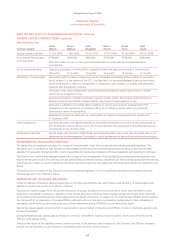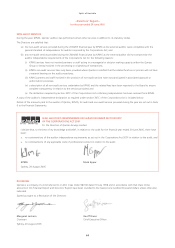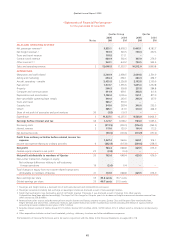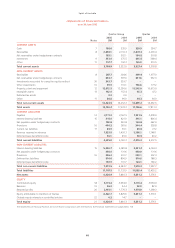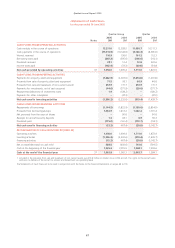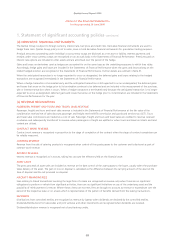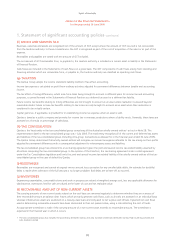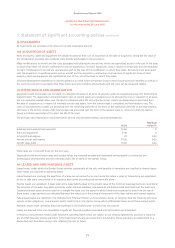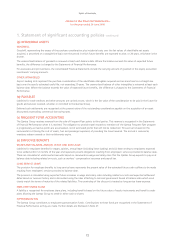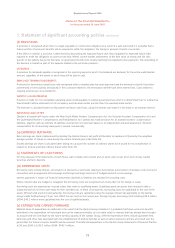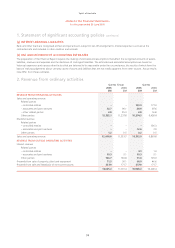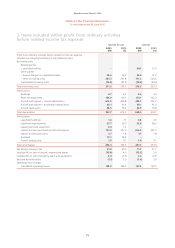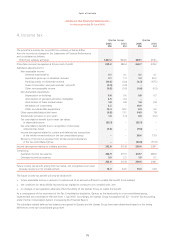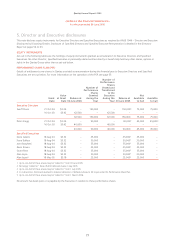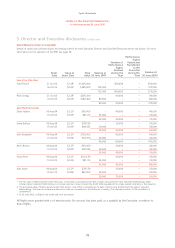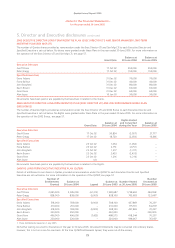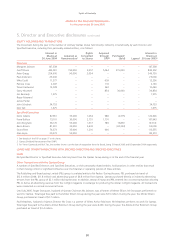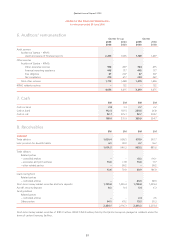Qantas 2005 Annual Report Download - page 73
Download and view the complete annual report
Please find page 73 of the 2005 Qantas annual report below. You can navigate through the pages in the report by either clicking on the pages listed below, or by using the keyword search tool below to find specific information within the annual report.
71
Qantas Annual Report 2005
~Notes to the Financial Statements~
for the year ended 30 June 2005
1. Statement of significant accounting policies continued
(l) INVESTMENTS
All investments are recorded at the lower of cost and recoverable amount.
(m) ACQUISITION OF ASSETS
Items of property, plant and equipment are initially recorded at their cost of acquisition at the date of acquisition, being the fair value of
the consideration provided plus incidental costs directly attributable to the acquisition.
Major modifications to aircraft and the costs associated with placing the aircraft into service are capitalised as part of the cost of the asset
to which they relate. All aircraft maintenance costs are expensed as incurred. Manpower costs in relation to employees that are dedicated
to major modifications to aircraft are capitalised as part of the cost of the modification to which they relate. Borrowing costs associated
with the acquisition of qualifying assets such as aircraft and the acquisition, construction or production of significant items of other
property, plant and equipment are capitalised as part of the cost of the asset to which they relate.
Software development expenditure is only recognised as an asset when the Qantas Group controls future economic benefits as a result of
the costs incurred and it is probable that those future economic benefits will eventuate and the costs can be measured reliably.
(n) DEPRECIATION AND AMORTISATION
Depreciation and amortisation are provided on a straight-line basis on all items of property, plant and equipment except for freehold and
leasehold land. The depreciation and amortisation rates of owned assets are calculated so as to allocate the costs or valuation of an asset,
less any estimated residual value, over the asset’s estimated useful life to the Qantas Group. Assets are depreciated or amortised from
the date of acquisition or, in respect of internally constructed assets, from the time an asset is completed and held ready for use. The
costs of improvements to assets are amortised over the remaining useful life of the asset or the estimated useful life of the improvement,
whichever is the shorter. Assets under finance lease are amortised over the term of the relevant lease or, where it is likely the Qantas
Group will obtain ownership of the asset, the life of the asset.
The principal asset depreciation and amortisation periods and estimated residual value percentages are:
Years
Residual
Value %
Buildings and leasehold improvements 10-50 0
Plant and equipment 3-40 0
Jet aircraft and engines 20 0-20
Non-jet aircraft and engines 10-20 0-20
Aircraft spare parts 15-20 0-20
These rates are in line with those for the prior year.
Depreciation and amortisation rates and residual values are reviewed annually and reassessed having regard to commercial and
technological developments and the estimated useful life of assets to the Qantas Group.
(o) LEASED AND HIRE PURCHASE ASSETS
Leased assets under which the Qantas Group assumes substantially all the risks and benefits of ownership are classified as finance leases.
Other leases are classified as operating leases.
Linked transactions involving the legal form of a lease are accounted for as one transaction when a series of transactions are negotiated
as one or take place concurrently or in sequence and cannot be understood economically alone.
Finance leases are capitalised. A lease asset and a lease liability equal to the present value of the minimum lease payments are recorded at
the inception of the lease. Any gains and losses under sale and leaseback arrangements are deferred and amortised over the lease term.
Capitalised leased assets are amortised on a straight-line basis over the period in which benefits are expected to arise from the use of
those assets. Lease payments are allocated between the reduction in the principal component of the lease liability and interest expense.
Fully prepaid leases are classified in the Statements of Financial Position as hire purchase assets, to recognise that the financing structures
impose certain obligations, commitments and/or restrictions on the Qantas Group which differentiate these aircraft from owned assets.
Payments made under operating leases are expensed in the financial year in which they are incurred.
Leases are deemed to be non-cancellable if significant financial penalties associated with termination are anticipated.
In respect of any premises rented under long-term operating leases which are subject to sub-tenancy agreements, provision is made for
any shortfall between primary payments to the head lessor less any recoveries from sub-tenants. These provisions are determined on a
discounted cash flow basis, using a rate reflecting the cost of funds.


